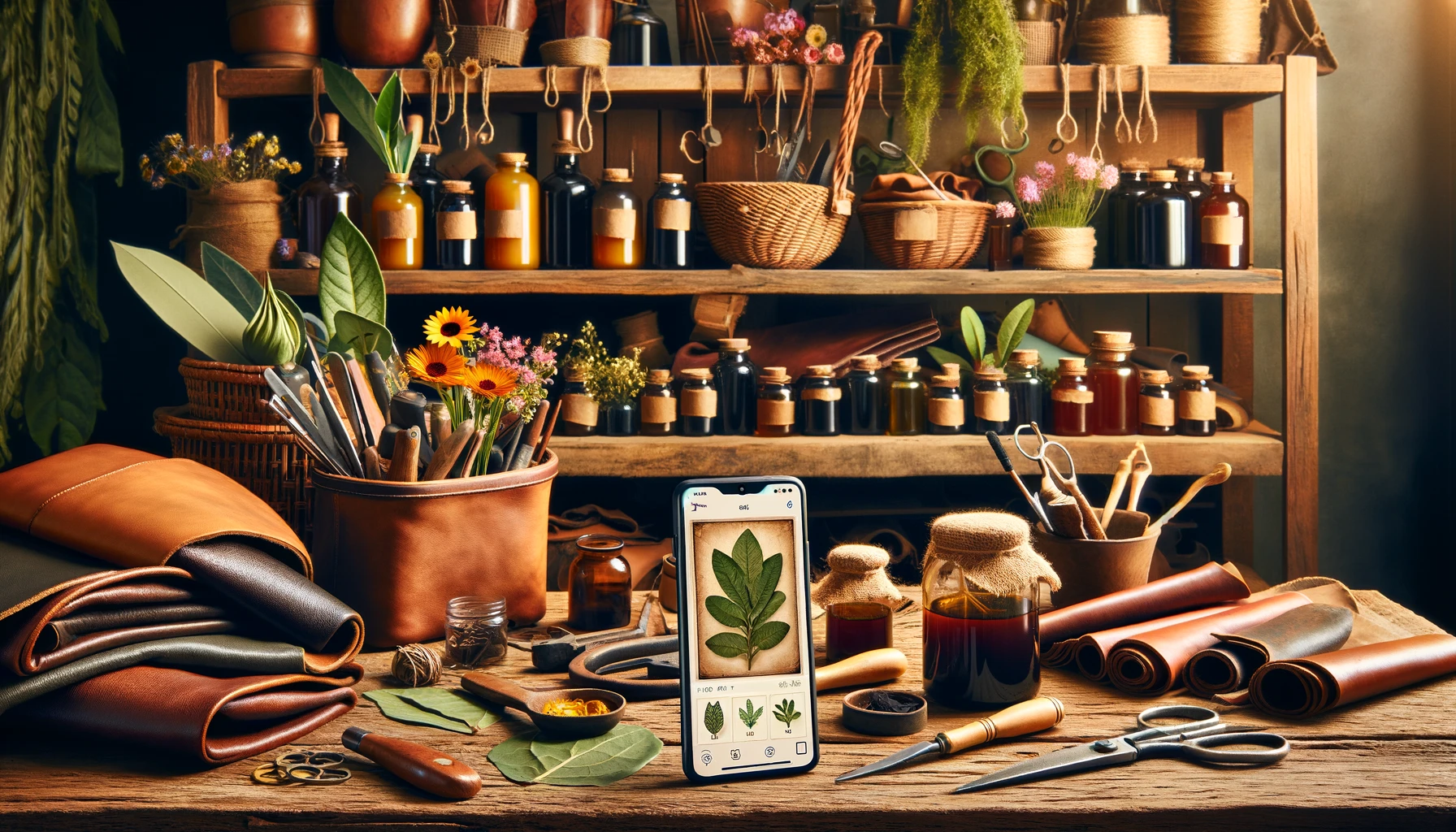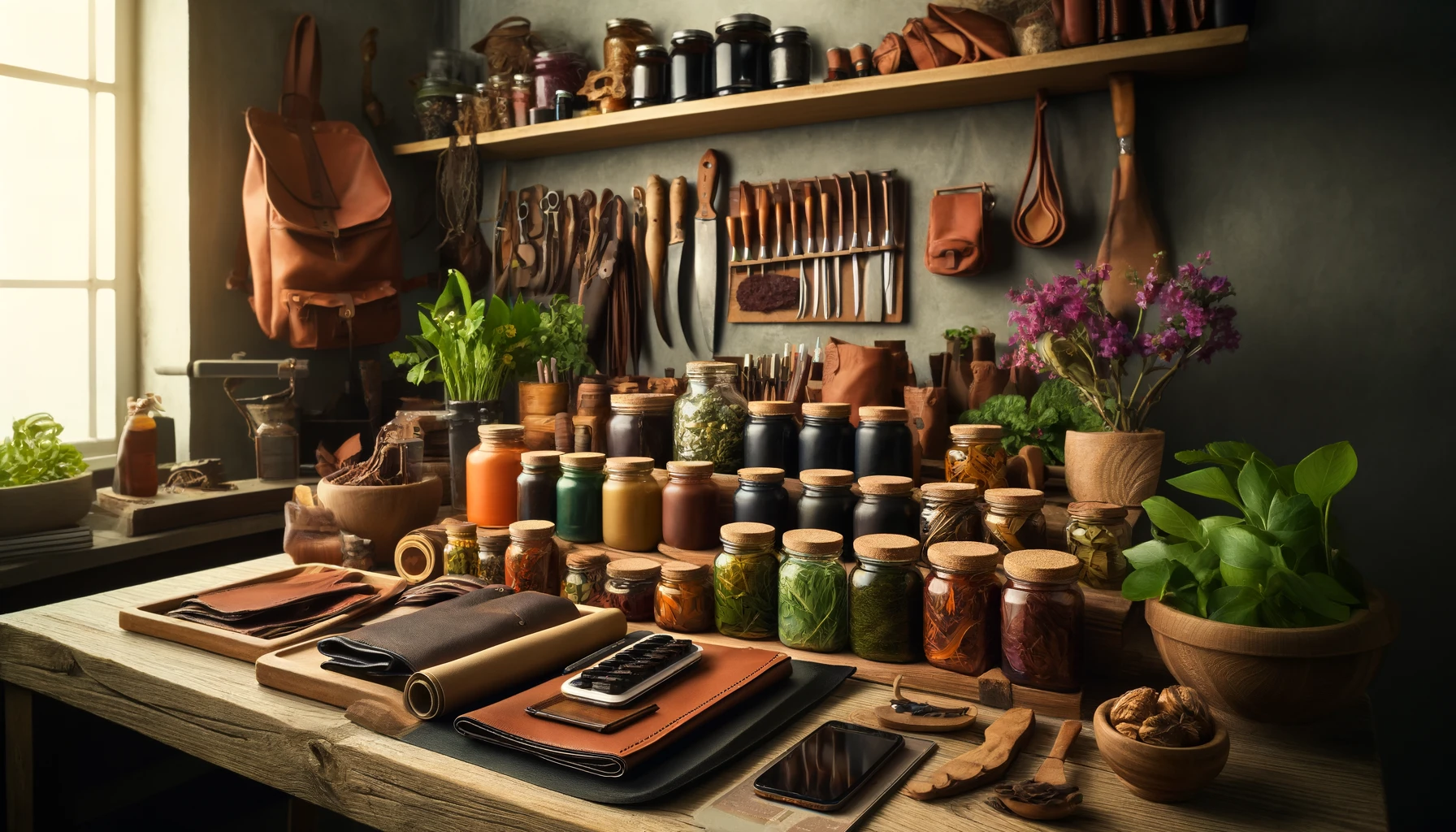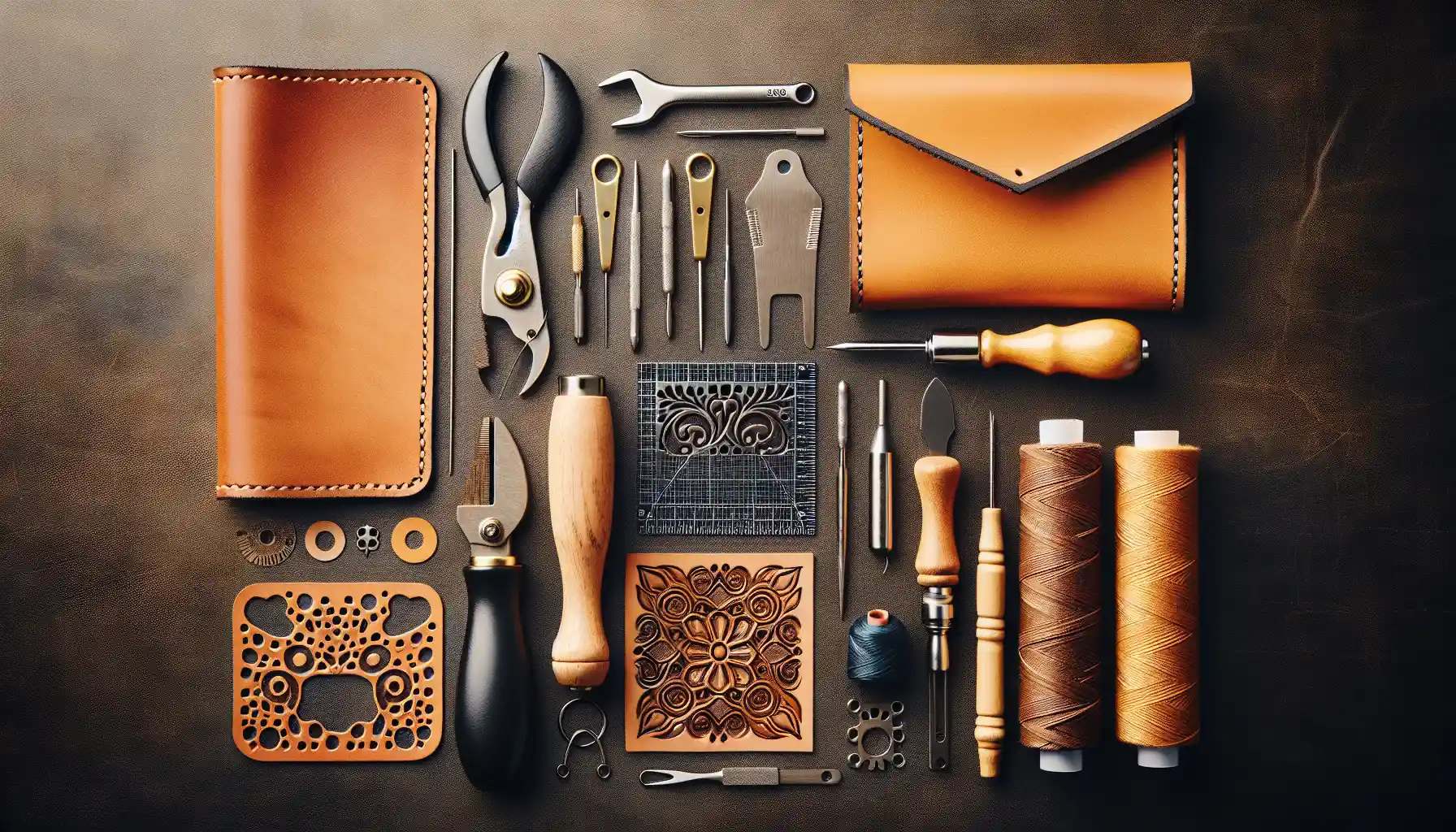Leather crafting is an age-old art form that has been practiced for centuries, and it has always been closely intertwined with the natural world. In recent years, there has been an increasing interest in using natural dyes derived from plants to color and enhance leather goods. This trend not only gives a unique and natural touch to the final products, but it also aligns with the growing demand for more sustainable and environmentally friendly practices in the craft community. One of the challenges in obtaining natural dyes is finding the right plants. Fortunately, thanks to modern technology, various flower identification (https://ai-plantfinder.com/) apps are now available to assist leather makers in this process. These apps utilize advanced algorithms and image recognition technology to identify plant species from photographs, making it easier for craftsmen to find and gather the plants they require for their dye projects.

Using natural dyes in leather craftwork has several advantages over synthetic dyes, making it an attractive choice for artisans who value sustainability and quality.
Eco-Friendliness: Natural dyes are derived from renewable sources, such as plants, and are biodegradable, making them a more environmentally friendly option compared to synthetic dyes, which can be harmful to the environment. Synthetic dyes often contain toxic chemicals that can leach into the soil and water, causing pollution and harming wildlife. In contrast, natural dyes break down more easily and have a minimal ecological footprint.
Unique Colors: Each plant species produces a unique color palette, allowing for a wide range of hues and shades that are difficult to replicate with synthetic dyes. This variety of color options adds depth and uniqueness to leather products. The process of extracting color from plants often produces variations that make each piece of dyed leather a true one-of-a-kind item. This unpredictability is part of the charm and allure of using natural dyes.
Historical Significance: Natural dyeing techniques have been used for centuries, and by embracing these traditional methods, leather crafters are preserving a rich cultural heritage and contributing to the preservation of this ancient art form. Many cultures around the world have long histories of using plant-based dyes, and by continuing these practices, modern crafters can connect with their cultural roots and honor the artisans of the past.
Health Benefits: Many natural dyes are free from harsh chemicals and toxins, making them a safer choice for both the crafter and the end-user, especially for those with sensitive skin or allergies. Synthetic dyes can cause skin irritation and other health issues due to the chemicals used in their production. In contrast, natural dyes are often gentler on the skin and do not pose the same health risks.
Plant identification apps can be invaluable tools for leather crafters looking to source natural dyes. Here are some popular apps and resources that can assist in this process:
AI Plant Finder: This app uses advanced image recognition technology to identify plants based on photographs of their leaves, flowers, or bark. It has a vast database of plant species and is available for both iOS and Android devices. The app also provides information on plant diseases, which can be helpful for those looking to ensure the health and viability of their dye plants.
PictureThis - Plant Identification: This app not only identifies plants but also provides detailed information about their characteristics, growing conditions, and potential uses, including their suitability for natural dyeing. With its user-friendly interface and comprehensive plant database, PictureThis is a valuable resource for both novice and experienced leather crafters.
iNaturalist: This app is a community-driven platform where users can upload photographs of plants and other organisms, and experts can help identify them. It also includes a vast database of plant species and their locations. iNaturalist's collaborative approach allows users to learn from one another and gain insights into the best plants for dyeing in their specific regions.
Embarking on the journey of sourcing natural dyes can be both exciting and educational for leather crafters. By leveraging plant identification apps and other resources, artisans can discover a wide array of plants that yield beautiful and diverse colors. Here are some commonly used plants and their corresponding dye colors:
Indigo (Indigofera tinctoria): Known for its rich blue hue, indigo is one of the oldest and most revered natural dyes. It requires a fermentation process to extract the dye, making it a more complex but rewarding option for crafters.
Madder (Rubia tinctorum): Madder roots produce vibrant reds and pinks, and the dye is known for its excellent colorfastness. Madder has been used for centuries in textile dyeing and continues to be a popular choice for leather crafters.
Turmeric (Curcuma longa): This common kitchen spice yields a bright yellow dye. While it is not as lightfast as some other natural dyes, turmeric is readily available and easy to use, making it a great option for beginners.
Black Walnut (Juglans nigra): The hulls of black walnuts produce rich browns and blacks. This dye is known for its strong color and ease of extraction, requiring only a simple boiling process.
Hibiscus (Hibiscus sabdariffa): The flowers of the hibiscus plant can produce a range of colors from pink to red, depending on the pH of the dye bath. Hibiscus is a versatile and beautiful dye plant.
By incorporating these plants into their dyeing practices, leather crafters can create unique and environmentally friendly pieces that reflect the natural world. The use of plant identification apps makes the process of finding and identifying these plants easier and more accessible, opening up a world of possibilities for artisans who wish to explore the rich tapestry of natural dyes.
As technology advances, it continues to blend seamlessly with traditional crafts, enhancing techniques and broadening possibilities. In leather crafting, the integration of plant identification apps represents a perfect fusion of old and new, allowing artisans to marry age-old dyeing methods with cutting-edge technology.
Plant identification apps have become increasingly sophisticated, utilizing advanced algorithms, machine learning, and vast databases to identify plant species accurately. Here’s how these apps typically work:
Image Capture: Users take a clear photograph of the plant they wish to identify, focusing on distinctive features such as leaves, flowers, bark, or seeds.
Upload and Analysis: The photograph is uploaded to the app, where image recognition software analyzes it. The app compares the photo against a comprehensive database of plant species.
Identification and Information: Within moments, the app provides a match along with detailed information about the plant, including its common and scientific names, habitat, characteristics, and potential uses, including dyeing properties.
These apps are designed to be user-friendly, making them accessible to both amateur and professional leather crafters. By utilizing such technology, artisans can expand their knowledge of local flora and discover new sources of natural dyes.
Once the plants have been identified, the next step is to source and prepare them for dyeing. This process involves several stages, each requiring careful attention to detail to achieve the best results.
Harvesting: Depending on the plant, different parts may be used for dyeing, such as leaves, flowers, roots, or bark. It’s crucial to harvest plants responsibly, ensuring that the natural habitat is not disturbed. Sustainable harvesting practices help preserve plant populations and maintain ecological balance.
Processing: After harvesting, the plant material needs to be processed to extract the dye. This may involve drying, crushing, or soaking the plants. Each plant has its unique preparation method that affects the color and quality of the dye.
Dye Extraction: The extracted plant material is then boiled or steeped in water to release the dye. Some dyes require mordants—substances that fix the dye to the leather and enhance color fastness. Common mordants include alum, iron, and copper, each contributing to different shades and tones.
Dyeing: The prepared dye bath is ready for the leather. Leather pieces are submerged in the dye solution, where they absorb the color. This process can take several hours to days, depending on the desired intensity and the type of leather. Regular stirring ensures even color distribution.
Rinsing and Finishing: After dyeing, the leather is thoroughly rinsed to remove excess dye and mordants. It is then dried and conditioned to restore its suppleness and shine. Proper finishing ensures that the dye remains vibrant and the leather retains its quality.
To illustrate the practical application of these techniques, let’s explore some case studies where leather crafters have successfully integrated natural dyes sourced through plant identification apps.
The Artisan's Collective, a group of leather crafters dedicated to sustainable practices, has embraced natural dyes to create unique, eco-friendly products. By using AI Plant Finder, they identified local plants such as marigold and hibiscus, which they now use to produce a range of vibrant dyes. The group has also adopted sustainable harvesting practices, ensuring that their dye sources are renewable and environmentally friendly.
Heritage Leatherworks specializes in crafting leather goods using traditional methods. With PictureThis, they have been able to revive ancient dyeing techniques by identifying historical dye plants native to their region. This approach has allowed them to create products that not only celebrate local heritage but also support biodiversity by promoting the use of indigenous plants.
Wild Dye Studio, a boutique leather shop, utilizes iNaturalist to explore and document dye plants in their area. By engaging with the app’s community, they have discovered rare plants that produce unique colors, setting their products apart in the market. The studio’s commitment to sustainable sourcing and innovative dyeing techniques has earned them a reputation for high-quality, eco-conscious leather goods.

The use of plant identification apps not only facilitates the sourcing of natural dyes but also enhances the creative process. Leather crafters can experiment with different plants and dyeing techniques, producing a rich array of colors and patterns. This exploration leads to greater innovation and artistic expression, pushing the boundaries of traditional leather crafting.
Moreover, the focus on natural dyes aligns with the global movement towards sustainability. By choosing eco-friendly dyeing methods, leather crafters contribute to reducing environmental impact, promoting biodiversity, and supporting local ecosystems. This conscious approach resonates with consumers who are increasingly seeking products that are both beautiful and sustainable.
Using natural dyes in leather crafting requires a blend of traditional knowledge and creative experimentation. The following techniques can help leather crafters achieve vibrant, long-lasting colors while maintaining the integrity of the leather:
Direct Application: This technique involves applying the dye directly to the leather using brushes, sponges, or spray bottles. It allows for detailed and controlled application, making it ideal for intricate designs or patterns. Crafters can layer colors to achieve depth and complexity.
Immersion Dyeing: In immersion dyeing, leather pieces are fully submerged in a dye bath. This method ensures even color coverage and is suitable for larger items such as bags or jackets. To prevent uneven coloring, it's essential to keep the leather moving in the dye bath and monitor the process closely.
Eco-Printing: Eco-printing is a technique that involves placing leaves, flowers, or other plant materials directly onto the leather and then steaming or boiling it to transfer the plant's pigments. This method creates unique, organic patterns and can be combined with mordants to enhance color fastness and variety.
Mordanting: Mordants are substances that help bind the dye to the leather, improving color intensity and durability. Common mordants include alum, iron, and tannins. Crafters can experiment with different mordants to achieve various hues from the same dye source. For instance, iron mordants tend to darken colors, while alum can brighten them.
Layering and Overdyeing: Layering involves applying multiple coats of dye to build up color depth and richness. Overdyeing is a similar technique where an already dyed piece is dipped into another dye bath to create new shades and tones. Both methods offer endless creative possibilities and can result in complex, multi-dimensional colors.
For those new to using natural dyes in leather crafting, starting with simple projects and gradually building skills can lead to rewarding results. Here are some tips to help beginners get started:
Research and Plan: Before beginning, research the types of plants available in your area and their dyeing properties. Use plant identification apps like AI Plant Finder and PictureThis to help identify suitable plants. Plan your project, including the colors you wish to achieve and the techniques you want to try.
Start Small: Begin with small leather pieces to practice dyeing techniques and experiment with different plants. This approach allows you to understand how various dyes interact with leather without committing to large projects.
Document Your Process: Keep a detailed record of your dyeing experiments, including the plants used, mordants, dyeing times, and results. This documentation will serve as a valuable reference for future projects and help you refine your techniques.
Safety First: While natural dyes are generally safer than synthetic dyes, some plants and mordants can still be harmful if not handled properly. Always wear gloves and work in a well-ventilated area. Research any potential hazards associated with the plants and chemicals you are using.
Experiment and Explore: Don’t be afraid to experiment with different plants, techniques, and mordants. The beauty of natural dyeing lies in its unpredictability and the unique results it produces. Embrace the creative process and enjoy the journey of discovery.
The resurgence of natural dyes in leather crafting is not only a nod to traditional methods but also a reflection of contemporary design trends. The demand for sustainable and eco-friendly products has led designers and consumers to appreciate the unique qualities of naturally dyed leather.
Sustainability: As awareness of environmental issues grows, more consumers seek products that align with their values. Naturally dyed leather goods, which use renewable resources and eco-friendly processes, appeal to this market. Brands that prioritize sustainability gain a competitive edge and build a loyal customer base.
Authenticity and Craftsmanship: The handcrafted nature of naturally dyed leather goods adds to their authenticity and appeal. Consumers are drawn to the story behind each piece, valuing the craftsmanship and attention to detail that goes into creating unique, one-of-a-kind items. This trend has sparked a renewed interest in artisanal products and traditional techniques.
Minimalism and Natural Aesthetics: Modern design often emphasizes simplicity, natural materials, and organic forms. Naturally dyed leather fits seamlessly into this aesthetic, offering soft, earthy tones that compliment minimalist designs. The subtle variations and imperfections in the dye add character and depth, enhancing the overall appeal.
Customization and Personalization: Natural dyes offer endless possibilities for customization. Artisans can create bespoke pieces tailored to individual preferences, from specific colors to unique patterns. This level of personalization is highly valued in the modern market, where consumers seek distinctive items that reflect their personal style.
Cultural and Historical Appreciation: Using natural dyes allows designers to tap into cultural and historical narratives, creating pieces that resonate with heritage and tradition. This connection adds layers of meaning and significance to the products, appealing to consumers who appreciate the cultural context and historical roots of their purchases.
The intersection of leather craft and botany, facilitated by plant identification apps, has opened up exciting avenues for artisans and designers. By embracing natural dyes, leather crafters can create beautiful, sustainable, and unique pieces that honor both tradition and innovation. The use of technology to identify and source plants has made this process more accessible and efficient, allowing more crafters to explore the rich potential of natural dyes.
As the demand for eco-friendly and authentic products continues to grow, the role of natural dyes in leather crafting is likely to expand. This trend not only benefits the environment but also enriches the creative process, offering endless possibilities for artistic expression and sustainable design. By integrating modern technology with traditional craftsmanship, leather crafters can contribute to a more sustainable future while celebrating the timeless beauty of natural dyes.


